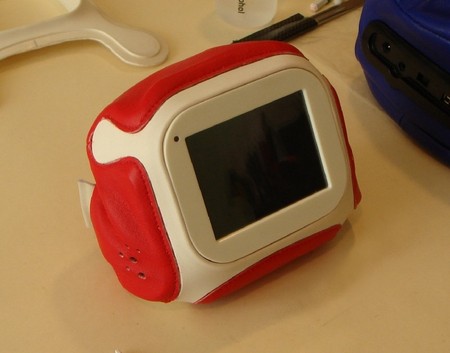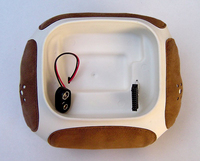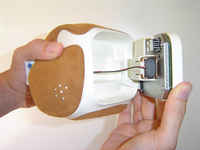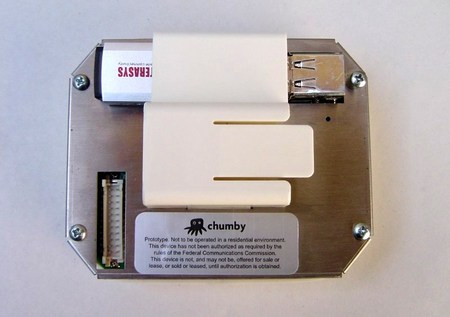Linux gadget to replace the clock radio?
Jun 14, 2007 — by LinuxDevices Staff — from the LinuxDevices Archive — 9 views Chumby, a venture-backed San Diego startup, is readying a soft, leather-covered Linux-powered gadget conceived as an Internet-era replacement for clock and table radios. Expected to ship in “early summer,” pending FCC approval, the “Chumby” device features open, hackable hardware, software, and yes,… “outerware” APIs.
Chumby, a venture-backed San Diego startup, is readying a soft, leather-covered Linux-powered gadget conceived as an Internet-era replacement for clock and table radios. Expected to ship in “early summer,” pending FCC approval, the “Chumby” device features open, hackable hardware, software, and yes,… “outerware” APIs.
(Click for larger view of the Chumby clock
digg this story |
The Chumby project was apparently conceived by notable hardware hackers Bernie Huang and Steve Tomlin. To date, a “few hundred” Chumbies were apparently soldered together by hand, and distributed to “hackers and artists,” according to the company.
The Chumby prototype described in detail on the Chumby website connects via an internal USB WiFi module to the user's home LAN. Users then program content for output on the device via a client application running on a host PC.
The Chumby prototype appears to have an X-Terasys 802.11n WiFi antenna attached to an internally mounted USB WLAN module
(Click to enlarge)
Typical content includes photos from camera phones, instant messages, website content feeds, horoscopes, weather, and artistic (Flash-based) content from a Chumby network community.



A few Chumby applications
(Click any to enlarge)
The Chumby offers no keyboard or other standard user interfaces. Instead, a bend sensor detects when the device is squeezed, while an accelerometer detects movement. A photosensor adds ambient light detection.
Everything about the Chumby was designed to be hacked and/or personalized by the user, including its “outerware” — a brown suede leather jacket easily removable with a seam ripper, the company said. Crafters can use an available flat cutout pattern to create personalized outfits for their Chumby.

“Chumby without a cause,” in James Dean style red leather jacket
(Click to enlarge)
More technically oriented hackers, meanwhile, can take advantage of hardware schematics, bill-of-materials (solder your own!), layer-by-layer board prints, open toolchains, sample code, and community resources such as a Wiki and discussion forum, in pursuit of the perfect “killer app” for the cuddly gadget. Additionally, Web developers familiar with Macromedia Flash can build their own “widgets” that, when downloaded to the device, display various kinds of content.
What's under the hood?
The Chumby is based on a 266MHz Freescale i.MX21 processor, and is equipped with 32MB of 133MHz SDRAM, and 64MB of NAND flash memory. The high-quality (TFT) QVGA (320×240) LCD display features LED backlighting controlled via PWM (pulse-width modulation).



Inside Chumby
(Click any image to enlarge)
Other hardware features include:
- 2W stereo speakers and headphone jack
- 2 x USB2.0 full-speed (12Mbps) ports
- 9-volt battery backup (in case power fails)
- Wide-input range (6-14V) switching power supply
- Serial debug port with standard timings
Additionally, the Chumby's processor module has a large pin header designed to connect via a “chumbilical” cord to the Chumby's back-panel I/O daughterboard. The chumbilical bus carries signals for a microphone input and SPI bus, although these are not exposed by the standard daughterboard.

Chumby's standard daughterboard
(Click to enlarge)
Availability
The Chumby is expected to ship “early” in the summer of 2007. Pricing was not disclosed.
This article was originally published on LinuxDevices.com and has been donated to the open source community by QuinStreet Inc. Please visit LinuxToday.com for up-to-date news and articles about Linux and open source.
